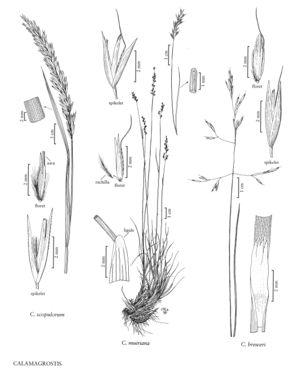Calamagrostis scopulorum
Plants without sterile culms; loosely cespitose, with rhizomes to 2 cm long, 2-3 mm thick. Culms (40) 50-92 cm, sometimes branched, sparsely to densely scabrous; nodes 2-3. Sheaths and collars smooth or scabrous; ligules (3) 4-7 (9) mm, obtuse, lacerate; blades 10-38 cm long, (2) 3-4 (7) mm wide, flat, scabridulous, adaxial surfaces glabrous or sparsely hairy. Panicles (4) 7-16 (18) cm long, (0.7) 1.1-2 (3) cm wide, nodding, contracted, pale green to purple-tinged; branches 1-5 (6.5) cm, sparsely to densely scabrous, usually spikelet-bearing to the base. Spikelets (4) 4.5-6 mm; rachilla prolongations 1-2 mm, hairy throughout, hairs 1.5-2.5 mm. Glumes keeled, mostly smooth, keels slightly scabrous distally, lateral-veins obscure, apices acuminate; callus hairs 2-3 mm, 0.5-0.6 times as long as the lemmas, somewhat sparse; lemmas 3.5-5 mm, 0.5-1.5 mm shorter than the glumes; awns (0.5) 1-1.5 (2) mm, attached to the upper 2/5 of the lemmas, not exserted, slender, straight, easily overlooked when short; anthers (1.8) 2-2.7 (3) mm. 2n = 28.
Distribution
Colo., N.Mex., Utah, Mont., Ariz., Wyo.
Discussion
Calamagrostis scopulorum grows on canyon slopes and wash bottoms, and in dry to moist montane to alpine habitats, often on rocky, sandy to silty soil, at 1000-3550 m. It grows from western Montana and Wyoming south to Arizona and New Mexico.
Selected References
None.
Lower Taxa
"decumbent" is not a number.
